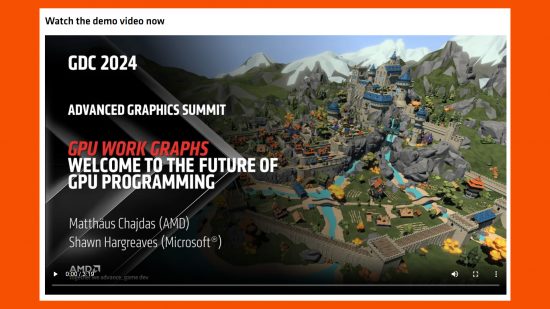One of many largest drawbacks with the best way video games at present render 3D scenes is that there’s nonetheless a stunning quantity of forwards and backwards communication required between the CPU and GPU. This overhead can decelerate graphics card processing in a large number of the way. Nevertheless, a brand new method demonstrated by AMD has managed to massively scale back this, boosting efficiency by 1.64x with with none additional processing energy required.
The method was demonstrated on an AMD Radeon RX 7900 XTX, the very best graphics card you may at present purchase for workloads with out ray tracing, however this system doesn’t require such a high-end GPU. As such, it might see efficiency will increase in lots of video games for a large number of GPUs.
This breakthrough considerations the truth that in many workloads, you will have an preliminary calculation completed on the GPU that then determines that some subsequent work additionally wants doing on the GPU. Nevertheless, within the present GPU workload setup, this subsequent work must be triggered by the CPU, so just a little spherical journey is required from the GPU to the CPU and again once more (typically utilizing the ExecuteIndirect command in DirectX’s D3D12). That is each inefficient and sluggish, relative to the GPU merely having the ability to deal with the entire course of itself.
An preliminary workaround for this was proposed just a few years in the past, with a setup known as work graphs. Work graphs permit a developer to outline an entire interrelated framework of potential capabilities and subsequent steps such that the GPU is aware of which perform to carry out subsequent with out having to go to the CPU.
Immediately’s demo, then, is an extension of labor graphs known as mesh nodes. As AMD’s, Matthäus Chajdas, places it within the AMD OpenGPU weblog, “Mesh nodes … permit a piece graph to feed immediately right into a mesh shader, turning the work graph itself into an amplification shader on steroids.”
Didn’t perceive all that? Nicely, in essence it permits for these intelligent work graph frameworks to immediately set off mesh shaders, that are the packages used to generate in-game terrain on the fly. It’s fairly a particular use case of the work graph setup however AMD demonstrates its energy with a demo that procedurally generates a whole bunch of parts (such because the ivy proven above – left is with much less generated, proper is with extra), all utilizing a single preliminary dispatch name to the GPU. In consequence, on this demo AMD might measure that the historically ExecuteIndirect technique was 1.64x slower than the mesh nodes system. You’ll be able to see the video demo on AMD’s weblog linked above.

What does all this imply for present and future video games? Nicely, it’s only one extra method builders can name upon to attempt to eke out extra efficiency from our video games. It’s probably not clear simply how a lot a way like this might have an effect on outright body fee however by releasing up system assets usually – and CPU assets particularly – there’s potential for efficiency to enhance because of different system bottlenecks being launched.












![[DEV] Doodle Defender – Coloration Matching Wave Protection Recreation – Out there now!](https://i1.wp.com/external-preview.redd.it/LGwgeeuMo2icaNCCQucRSIfuboEIM52dJuKzflzWmNI.jpg?width=320&crop=smart&auto=webp&s=d4751ef2fd787eb4e29c1452f3f386d7e586d1a2&w=120&resize=120,86)



